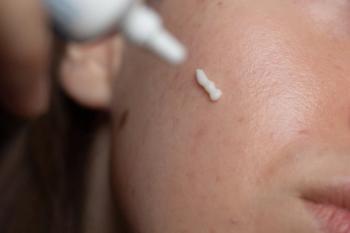
OX40/OX40L Inhibitors Offer Upstream Signaling Pathways in Atopic Dermatitis
Key Takeaways
- OX40 and OX40 ligand-targeting biologics offer a novel mechanism by interfering with the co-stimulatory pathway, suppressing cytokine cascades in atopic dermatitis.
- These biologics promote regulatory T cell expansion and reduce memory T cell populations, potentially addressing refractory or heterogeneous AD cases.
At RAD 2025, Christopher Bunick, MD, PhD, presented data on amlitelimab and rocatinlimab, highlighting their potential to suppress cytokine signaling and more.
“OX40 and OX40 ligand-targeting biologics are a new entry into the atopic dermatitis therapeutic landscape, and I really had a great time speaking with my friend and colleague, Dr Johann E Gudjonsson, about this topic. I look forward to seeing more data come out on these therapies in the months ahead,” said Christopher Bunick, MD, PhD, in an interview with Dermatology Times.
Bunick, associate professor of dermatology at Yale School of Medicine in New Haven, Connecticut, and editor in chief of Dermatology Times, presented an overview of a novel class of immunomodulatory therapeutics: OX40 and OX40 ligand-targeting biologics, at the
Bunick positioned OX40 and OX40 ligand-targeting biologics within the broader therapeutic landscape, comparing them with existing options.
“Current mono-targeted biologics are sort of midstream in the signaling pathway, whereas JAK inhibitors are downstream,” Bunick noted.
OX40-OX40L therapeutics function at the interface between antigen-presenting cells and activated T cells. According to Bunick, by interfering with this co-stimulatory pathway, these biologics suppress the cascade of multiple cytokines contributing to AD’s pathogenesis, including its well-documented immunologic heterogeneity.
Beyond cytokine suppression, OX40/OX40L inhibition appears to induce broader immunoregulatory effects. Bunick highlighted the potential for these therapeutics to promote regulatory T cell expansion while reducing memory T cell populations, which may contribute to the persistence and recurrence of chronic atopic dermatitis.
Referencing his lab’s structural biology research, Bunick presented data showing the molecular distinctions between leading OX40/OX40L inhibitors: amlitelimab, rocatinlimab, and telazorlimab. He reviewed epitope-specific binding patterns and proposed mechanistic differences that may inform clinical behavior and future biomarker development.
Bunick also reviewed clinical efficacy and safety data among the OX40/OX40L therapeutics. He presented key findings from pivotal trials: phase 3 results for rocatinlimab and phase 2b data for amlitelimab. Both therapeutics demonstrated promising reductions in EASI scores and favorable proportions of patients achieving IGA 0/1 and EASI 75 end points, which were sustained through 52 weeks. Safety profiles were generally favorable, with no unexpected adverse signals, supporting their potential as well-tolerated long-term options for moderate to severe AD.2,3
According to Bunick, OX40 and OX40L-targeting biologics represent a mechanistically distinct and promising addition for patients with atopic dermatitis. With their upstream targeting, immunomodulatory benefits, and emerging clinical data, they may address unmet needs, particularly in patients with refractory or heterogeneous disease. Bunick concluded by expressing excitement for ongoing studies and the potential for future combination or sequential therapies guided by mechanistic insights.
References
- Gudjonsson J, Bunick CG. Assessing the evidence for OX40-OX40L Axis inhibition for the treatment of atopic dermatitis. Presented at: 2025 Revolutionizing Atopic Dermatitis Conference; June 6-7, 2025; Nashville, TN
- Guttman-Yassky E, Simpson E, Bissonnette R, et al. ROCKET: a phase 3 program evaluating the efficacy and safety of rocatinlimab in moderate-to-severe atopic dermatitis. Immunotherapy. 2025 Feb;17(2):83-94. doi: 10.1080/1750743X.2025.2464528
- Weidinger S, Blauvelt A, Papp KA, et al Phase 2b randomized clinical trial of amlitelimab, an anti-OX40 ligand antibody, in patients with moderate-to-severe atopic dermatitis. J Allergy Clin Immunol. 2025 Apr;155(4):1264-1275. doi: 10.1016/j.jaci.2024.10.031
Newsletter
Like what you’re reading? Subscribe to Dermatology Times for weekly updates on therapies, innovations, and real-world practice tips.


















